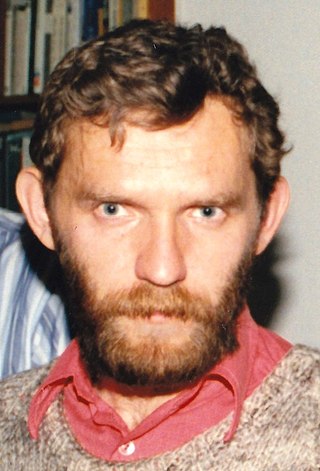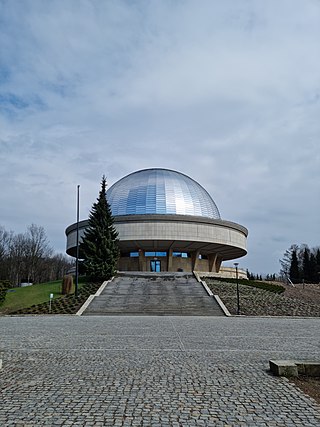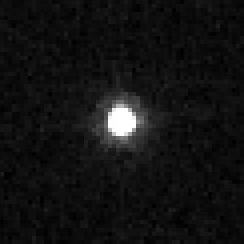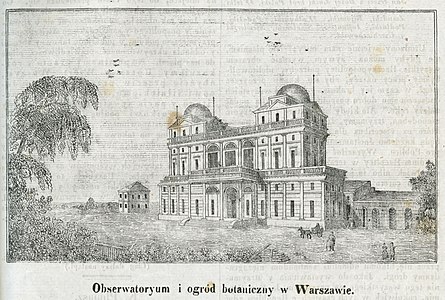
Aleksander Wolszczan is a Polish astronomer. He is the co-discoverer of the first confirmed extrasolar planets and pulsar planets. He is a graduate of the Nicolaus Copernicus University in Toruń and works as a professor at the Pennsylvania State University.

Bohdan Paczyński or Bohdan Paczynski was a Polish astronomer notable for his theories and work in the fields of stellar evolution, accretion discs, and gamma ray bursts. He is the recipient of the Eddington Medal (1987), the Henry Draper Medal (1997), the Gold Medal of the Royal Astronomical Society (1999), and the Order of Polonia Restituta (2007).

Observational astronomy is a division of astronomy that is concerned with recording data about the observable universe, in contrast with theoretical astronomy, which is mainly concerned with calculating the measurable implications of physical models. It is the practice and study of observing celestial objects with the use of telescopes and other astronomical instruments.

The National Optical Astronomy Observatory (NOAO) was the United States national observatory for ground-based nighttime ultraviolet-optical-infrared (OUVIR) astronomy. The National Science Foundation (NSF) funded NOAO to provide forefront astronomical research facilities for US astronomers. Professional astronomers from any country in the world could apply to use the telescopes operated by NOAO under the NSF's "open skies" policy.

The Cerro Tololo Inter-American Observatory (CTIO) is an astronomical observatory located on the summit of Mt. Cerro Tololo in the Coquimbo Region of northern Chile, with additional facilities located on Mt. Cerro Pachón about 10 kilometres (6.2 mi) to the southeast. It is approximately 80 kilometres (50 mi) east of La Serena, where support facilities are located. The principal telescopes at CTIO are the 4 m Víctor M. Blanco Telescope, named after Puerto Rican astronomer Víctor Manuel Blanco, and the 4.1 m Southern Astrophysical Research Telescope, which is situated on Cerro Pachón. Other telescopes on Cerro Tololo include the 1.5 m, 1.3 m, 1.0 m, and 0.9 m telescopes operated by the SMARTS consortium. CTIO also hosts other research projects, such as PROMPT, WHAM, and LCOGTN, providing a platform for access to the southern hemisphere for U.S. and worldwide scientific research.

Stardome Observatory & Planetarium is a public astronomical observatory and planetarium situated in Maungakiekie/One Tree Hill Domain in Auckland, New Zealand.

The Haute-Provence Observatory is an astronomical observatory in the southeast of France, about 90 km east of Avignon and 100 km north of Marseille. It was established in 1937 as a national facility for French astronomers. Astronomical observations began in 1943 using the 1.20 m telescope, and the first research papers based on observations made at the observatory were published in 1944. Foreign observers first used the observatory in 1949, when Geoffrey and Margaret Burbidge visited.

The Mount Suhora Observatory is an astronomical observatory owned and operated by the Astronomy department of the Pedagogical University of Cracow. It is located on Mount Suhora in the Gorce Mountains within the Gorce National Park, 50 km south of Kraków.

Las Campanas Observatory (LCO) is an astronomical observatory managed by the Carnegie Institution for Science (CIS). Located in Chile's Atacama Region, it sits about 100 kilometres (62 mi) northeast of the city of La Serena. The LCO's telescopes and facilities are positioned near the northern end of a 7 km (4.3 mi) mountain ridge. Cerro Las Campanas, situated near the southern end of this ridge and standing over 2,500 m (8,200 ft) tall, will be the future site of the Giant Magellan Telescope.

Grzegorz Pojmański, is a Polish astronomer and professor at the Warsaw University Astronomical Observatory, Poland. In 1997 Pojmański together with professor Bohdan Paczyński implemented the project All Sky Automated Survey (ASAS). With the ASAS Alert System Pojmański discovered two new comets: C/2004 R2 (ASAS) and C/2006 A1 (Pojmański). Pojmański connects with the ASAS automatic telescope located in Las Campanas Observatory, Chile, via Internet.

The All Sky Automated Survey (ASAS) is a Polish project implemented on 7 April 1997 to do photometric monitoring of approximately 20 million stars brighter than 14 magnitude all over the sky. The automatic telescopes discovered two new comets in 2004 and 2006. The ASAS-South, located in Chile and ASAS-North, located in Hawai'i, are managed by Grzegorz Pojmański of the Warsaw University Observatory via the internet.

The Optical Gravitational Lensing Experiment (OGLE) is a Polish astronomical project based at the University of Warsaw that runs a long-term variability sky survey (1992–present). The main goals are the detection and classification of variable stars, discovery of microlensing events, dwarf novae, and studies of the structure of the Galaxy and the Magellanic Clouds. Since the project began in 1992, it has discovered a multitude of extrasolar planets, together with the first planet discovered using the transit method (OGLE-TR-56b) and gravitational microlensing. The project has been led by professor Andrzej Udalski since its inception.

Comet Pojmański is a non-periodic comet discovered by Grzegorz Pojmański on January 2, 2006, and formally designated C/2006 A1. Pojmański discovered the comet at Warsaw University Astronomic Observatory using the Las Campanas Observatory in Chile as part of the All Sky Automated Survey (ASAS). Kazimieras Cernis at the Institute of Theoretical Physics and Astronomy at Vilnius, Lithuania, located it the same night and before the announcement of Pojmański's discovery, in ultraviolet images taken a few days earlier by the SWAN instrument aboard the SOHO satellite. A pre-discovery picture was later found from December 29, 2005.

The Silesian Planetarium also Silesian Planetarium and Astronomical Observatory is the largest and oldest planetarium in Poland. It was founded on 4 December 1955 to commemorate Nicolaus Copernicus. It is located in the Silesian Park, on the boundary between the Katowice and Chorzów cities in the Metropolis GZM.
The Microlensing Follow-Up Network is an informal group of observers who monitor high magnification gravitational microlensing events in the Milky Way's Galactic Bulge. Its goal is to detect extrasolar planets via microlensing of the parent star by the planet. μFUN is a follow-up network - they monitor microlensing events identified by survey groups such as OGLE and Microlensing Observations in Astrophysics (MOA).

471143 Dziewanna (provisional designation 2010 EK139) is a trans-Neptunian object in the scattered disc, orbiting the Sun in the outermost region of the Solar System.
Andrzej Jarosław Udalski is a Polish astronomer and astrophysicist, and director of the Astronomical Observatory of the University of Warsaw. He is also head of the Department of Observational Astrophysics at Astronomical Observatory, the head and project manager of the Optical Gravitational Lensing Experiment, and editor of the quarterly journal Acta Astronomica.

Time-domain astronomy is the study of how astronomical objects change with time. Said to have begun with Galileo's Letters on Sunspots, the field has now naturally expanded to encompass variable objects beyond the Solar System. Temporal variation may originate from movement of the source, or changes in the object itself. Common targets include novae, supernovae, pulsating stars, flare stars, blazars and active galactic nuclei. Optical time domain surveys include OGLE, HAT-South, PanSTARRS, SkyMapper, ASAS, WASP, CRTS, GOTO, and the forthcoming LSST at the Vera C. Rubin Observatory.
The Polish Astronomical Society is science society in Poland, founded in 1923, with headquarters in Warsaw. Members of PTA are professional astronomers. Purpose of the association is promoting the development of astronomical science, their teaching and outreach in community. PTA is involved in publishing astronomical books, as well as popular science magazine Urania - Postępy Astronomii. PTA is also a producer of a TV series Astronarium about astronomy and space. The society organizes conferences and contests. Current President of PTA is Marek Sarna and number of members is around 280. Polish Astronomical Society is a member of the European Astronomical Society.

The Nicolaus Copernicus Astronomical Center, also CAMK or NCAC, is a Polish scientific research institute of the Polish Academy of Sciences headquartered in Warsaw, Poland. It is a leading institution in the country in the field of astronomy.
























